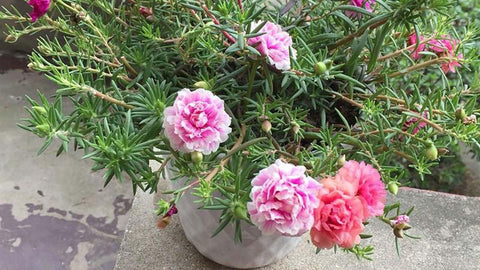What Flower Requires The Least Amount Of Water?
Which Flower Requires the Least Amount of Water? A Comprehensive Guide
Water conservation is a growing concern worldwide, particularly in gardening and landscaping. Choosing plants that require minimal water can significantly reduce water usage and promote sustainable gardening practices. This article explores various flowers that thrive on limited water, their characteristics, and how to care for them. We will also provide a detailed FAQ section to address common questions about low-water flowers.
Understanding Drought-Tolerant Flowers
Drought-tolerant flowers are plants that can survive and thrive with minimal water. These flowers are often native to arid regions and have adapted to conserve moisture. They typically possess features such as deep root systems, waxy leaves, and the ability to store water.
Benefits of Growing Drought-Tolerant Flowers
- Water Conservation: Reduces the need for irrigation, conserving water resources.
- Low Maintenance: Requires less care and attention, making them ideal for busy gardeners.
- Environmental Benefits: Supports local ecosystems and wildlife by providing habitats and food sources.
- Cost-Effective: Lowers water bills and reduces the need for fertilizers and pesticides.
Top Drought-Tolerant Flowers
1. California Poppy (Eschscholzia californica)
- Description: The California poppy is a vibrant orange flower that blooms in spring and summer. It is the state flower of California.
- Water Requirements: Very low; requires minimal irrigation once established.
- Growing Conditions: Prefers well-drained soil and full sun.
2. Lavender (Lavandula spp.)
- Description: Lavender is a fragrant herb with purple flowers that attract pollinators. It is commonly used in aromatherapy and cooking.
- Water Requirements: Low; drought-resistant once established.
- Growing Conditions: Thrives in well-drained soil and full sun.
3. Sedum (Sedum spp.)
- Description: Sedum, or stonecrop, is a succulent plant with fleshy leaves and star-shaped flowers. It comes in various colors and forms.
- Water Requirements: Very low; can survive in dry conditions.
- Growing Conditions: Prefers well-drained soil and full sun to partial shade.
4. Coneflower (Echinacea spp.)
- Description: Coneflowers are hardy perennials with daisy-like flowers that come in various colors. They are known for attracting butterflies.
- Water Requirements: Moderate; drought-tolerant once established.
- Growing Conditions: Prefers well-drained soil and full sun to partial shade.
5. Yarrow (Achillea millefolium)
- Description: Yarrow is a perennial herb with feathery leaves and clusters of small flowers. It is known for its medicinal properties.
- Water Requirements: Low; drought-resistant once established.
- Growing Conditions: Thrives in well-drained soil and full sun.
6. Zinnia (Zinnia elegans)
- Description: Zinnias are colorful annuals that bloom throughout the summer. They are easy to grow and attract butterflies.
- Water Requirements: Moderate; tolerates dry conditions once established.
- Growing Conditions: Prefers well-drained soil and full sun.
7. Black-eyed Susan (Rudbeckia hirta)
- Description: Black-eyed Susan is a perennial flower with bright yellow petals and a dark center. It is a favorite among pollinators.
- Water Requirements: Moderate; drought-tolerant once established.
- Growing Conditions: Thrives in well-drained soil and full sun.
Table: Comparison of Drought-Tolerant Flowers
| Flower Name | Water Requirements | Blooming Season | Growing Conditions |
|---|---|---|---|
| California Poppy | Very Low | Spring-Summer | Well-drained soil, full sun |
| Lavender | Low | Summer | Well-drained soil, full sun |
| Sedum | Very Low | Summer-Fall | Well-drained soil, full sun to partial shade |
| Coneflower | Moderate | Summer | Well-drained soil, full sun to partial shade |
| Yarrow | Low | Summer | Well-drained soil, full sun |
| Zinnia | Moderate | Summer | Well-drained soil, full sun |
| Black-eyed Susan | Moderate | Summer | Well-drained soil, full sun |
Caring for Drought-Tolerant Flowers
Planting Tips
- Soil Preparation: Ensure the soil is well-drained. Amend heavy soils with organic matter to improve drainage.
- Mulching: Apply a layer of mulch around the plants to retain moisture and suppress weeds.
- Watering: Water the plants deeply but infrequently to encourage deep root growth. Once established, reduce watering.
Maintenance Tips
- Pruning: Deadhead spent flowers to encourage new blooms and maintain plant shape.
- Fertilization: Use a slow-release fertilizer sparingly, as drought-tolerant plants typically require less feeding.
- Pest Control: Monitor for pests and diseases, but many drought-tolerant plants are resilient and resistant to common issues.
FAQ Section
1. What flowers require the least amount of water?
Flowers such as California poppy, lavender, sedum, coneflower, yarrow, zinnia, and black-eyed Susan are known for their low water requirements.
2. How do I care for drought-tolerant flowers?
Care involves planting in well-drained soil, applying mulch, watering deeply but infrequently, and maintaining the plants through pruning and minimal fertilization.
3. Can I grow drought-tolerant flowers in containers?
Yes, many drought-tolerant flowers can thrive in containers, provided the pots have good drainage and the plants are watered appropriately.
4. Do drought-tolerant flowers attract pollinators?
Yes, many drought-tolerant flowers, such as coneflowers and black-eyed Susans, are excellent for attracting pollinators like bees and butterflies.
5. Are drought-tolerant flowers suitable for all climates?
While drought-tolerant flowers are adapted to dry conditions, they can be grown in various climates. However, they may require some additional care in extremely wet or humid conditions.
6. How can I incorporate drought-tolerant flowers into my garden?
Drought-tolerant flowers can be incorporated into garden beds, borders, or containers. Grouping them together can create a visually appealing landscape while conserving water.
Conclusion
Choosing flowers that require minimal water is an effective way to promote sustainable gardening practices and conserve water resources. Drought-tolerant flowers like California poppy, lavender, and sedum not only thrive in dry conditions but also provide beauty and ecological benefits to gardens. By understanding their care requirements and incorporating them into your landscape, you can create a vibrant and low-maintenance garden.For more information on drought-tolerant plants, you can refer to the Wikipedia page on Drought-Tolerant Plants.



Post Comment